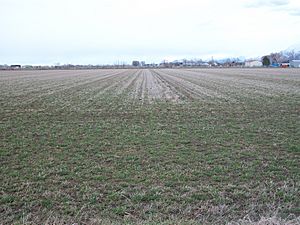West Weber, Utah facts for kids
Quick facts for kids
West Weber, Utah
|
|
|---|---|
|
Township
|
|

An agricultural field in West Weber, March 2011
|
|
| Country | United States |
| State | Utah |
| County | Weber |
| Named for | Weber River |
| Elevation | 4,239 ft (1,292 m) |
| GNIS feature ID | 1447187 |
West Weber is a small community in western Weber County, Utah, United States. It is an unincorporated community, which means it doesn't have its own local government like a city does.
About West Weber
This community is located to the west and northwest of Ogden. West Weber was officially set up as a church district, called a ward, in 1877. At that time, about 700 people lived there.
The community got its name from the nearby Weber River. The word "West" was added to its name to make sure people didn't confuse it with other places in the area that also had "Weber" in their names.
West Weber is found northeast of where two Utah state roads, Route 39 and Route 134, meet. The closest major highway is Interstate 84/Interstate 15, which is about 3.3 miles (5.3 km) to the east. Route 39 leads directly to this highway.
| Historical population | |||
|---|---|---|---|
| Census | Pop. | %± | |
| 1880 | 603 | — | |
| 1890 | 722 | 19.7% | |
| 1900 | 822 | 13.9% | |
| 1910 | 823 | 0.1% | |
| 1920 | 379 | −53.9% | |
| 1930 | 409 | 7.9% | |
| 1940 | 396 | −3.2% | |
| 1950 | 417 | 5.3% | |
| Source: U.S. Census Bureau | |||
The community is home to the West Weber Elementary School. The Weber River flows close by, and a bridge was built over the river in 1903 to help people cross.
Farming and Economy
The eastern part of West Weber was once known as Wilson. Early settlers like John Staker and Ebenezer Wiggins were growing grain there as early as 1853.
In 1903, the soil in West Weber was thought to be quite poor for farming compared to other areas. However, farmers learned to grow beets successfully. They did this by digging special wells called artesian wells to bring water for irrigation. The soil also had natural substances called nitrates, which helped plants grow better.
Archibald McFarland dug the first canal in West Weber in 1859. This canal brought water from a small stream connected to the Weber River for irrigation. In 1860 and 1861, early settlers spent about $2500 to water ten small farms in the area. Studies in 1903 showed that when the soil had less salt (alkali), the beets grown there were purer and better quality. This showed how important good soil and water management were for farming in West Weber.



